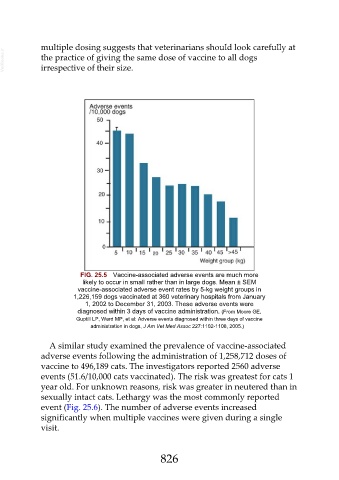Page 826 - Veterinary Immunology, 10th Edition
P. 826
multiple dosing suggests that veterinarians should look carefully at
VetBooks.ir the practice of giving the same dose of vaccine to all dogs
irrespective of their size.
FIG. 25.5 Vaccine-associated adverse events are much more
likely to occur in small rather than in large dogs. Mean ± SEM
vaccine-associated adverse event rates by 5-kg weight groups in
1,226,159 dogs vaccinated at 360 veterinary hospitals from January
1, 2002 to December 31, 2003. These adverse events were
diagnosed within 3 days of vaccine administration. (From Moore GE,
Guptill LP, Ward MP, et al: Adverse events diagnosed within three days of vaccine
administration in dogs, J Am Vet Med Assoc 227:1102-1108, 2005.)
A similar study examined the prevalence of vaccine-associated
adverse events following the administration of 1,258,712 doses of
vaccine to 496,189 cats. The investigators reported 2560 adverse
events (51.6/10,000 cats vaccinated). The risk was greatest for cats 1
year old. For unknown reasons, risk was greater in neutered than in
sexually intact cats. Lethargy was the most commonly reported
event (Fig. 25.6). The number of adverse events increased
significantly when multiple vaccines were given during a single
visit.
826

